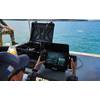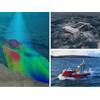Tiny Ripples Important to Ocean Mixing
Study to address small waves’ ability to distribute nutrients or harmful contaminants
Even the smallest ripple can have a huge effect on ocean mixing and distribution of harmful contaminants, said Texas A&M University-Corpus Christi researcher, Dr. Darek Bogucki, Assistant Professor of Physical Oceanography. Bogucki was recently awarded a $409,000 grant from the National Science Foundation (NSF) to study the impact of non-breaking surface waves and the turbulence they create in our oceans.
The same processes that regulate the global climate also govern the dispersion of phytoplankton and contaminants such as oil droplets from an oil spill. This is exactly why Bogucki and the NSF believe that the study of ocean mixing is necessary.
“It is important to look at how the upper two meters of the ocean responds to small ocean disturbances,” Bogucki said. “By including a more realistic and turbulent flow in our research we can dramatically improve models that could determine how oil spreads during a spill or even climate change.”
When people think of waves, they usually conjure up images of the classic Hawaiian barrel wave. These monstrous “tubes” are a well-studied aspect of ocean mixing and are created by winds that cause turbulence on the waters surface. Less known are the smaller waves that do not crest in the classic wave shape. These ripple-like waves are called non-breaking surface waves and researchers have overlooked the impact they could have on ocean mixing.
In collaboration with researchers from the University of Miami’s SUSTAIN wind-wave laboratory, Bogucki will look at the amount of turbulence that occurs when these ripples are created. A wind and wave generator will be used to create the non-breaking surface waves in a water tank. Bogucki will then use his unique optical sensor to sense the temperature distribution of water in the tank. As the ripples create turbulence, the warmer top layer of water should be forced down to mix with the cooler layers.
“With this experiment, we plan to challenge the status quo and use rigorous research to address the knowledge gap regarding non-breaking surface waves,” said Bogucki. “We also plan to collaborate with the student-run video project Waterlust to produce and distribute short wave and turbulence videos.”
All data gathered from the University of Miami SUSTAIN laboratory will be included in a new joint program with the College of Science and Engineering at Texas A&M University-Corpus Christi. Two graduate students will be directly supported by the study and participate in the data collection and processing effort over the next three years.
Bogucki heads the Marine Sensing and Simulation Group within the Department of Physical and Environmental Sciences at Texas A&M-Corpus Christi. The lab focuses on coastal processes, optical wavefront sensing, polarimetric measurements and remote sensing.

















 February 2024
February 2024



